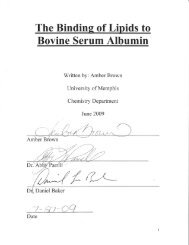Organic Reaction Types
Organic Reaction Types
Organic Reaction Types
Create successful ePaper yourself
Turn your PDF publications into a flip-book with our unique Google optimized e-Paper software.
<strong>Organic</strong> <strong>Reaction</strong> <strong>Types</strong>
• <strong>Organic</strong> reactions can be classified based on:– Net Result• Substitution• Addition• Elimination• Rearrangement• Acid-Base– Mechanism• Polar• Radical– Oxidation State Changes• Oxidation-Reduction• Non-Oxidation-Reduction
<strong>Reaction</strong> <strong>Types</strong> by Net Result - I• Substitution: One group replaces anotherCH 3 CH 2 Br + NaI CH 3 CH 2 I + NaBr• Addition: A molecule adds across a pi bondCH 2 =CH 2 + HBr H C C• Elimination: One molecule is lost to give a pi bondHH CHCBrHHCH 2 =CH 2 + HBr• Rearrangement: Constitutional change in carbonCHskeleton3BrH 3 C C CH CH 2+ HBrH 3 CHHBrHHH 3 C C CH CH 3H 3 CCH 3
<strong>Reaction</strong> <strong>Types</strong> by Net Result - II• Acid-Base <strong>Reaction</strong>s– Bronsted definition: transfer of H + from acid to baseH 3 CO+ NH 3OC+ NHC3OHH 3 C O -acid base conjugate base conjugate acid– Lewis definition: transfer of electron pair from baseto acidH+ClClCH 3 ClCH 3 Cl + AlAlCl ClClClbaseacid
Problem: Classify the Following<strong>Reaction</strong>sH 3 CH 3 CCH 3+ H 2 (CH 3 ) 2 CHCH(CH 3 ) 2CH 3AdditionBr 2 + FeBr 3 Br-Br-FeBr 3Lewis Acid-Base+ CH 3 ClAlCl 3CH 3+ HClSubstitutionOHH + , H 2 OOAddition
<strong>Reaction</strong> Type by Mechanism• Polar <strong>Reaction</strong>s: Involve heterolytic bondcleavage (heterolytic – uneven break: allelectrons go to one atom)H 3 CH 3 CH 3 CCBrH 3 CH 3 CH 3 C• Radical <strong>Reaction</strong>s: Involve homolytic bondcleavage (homolytic – even break: one electrongoes to each atom)OOCH 3 C O O C CH 3CO+ BrOC +H 3 C O O C CH 3
A Note on <strong>Reaction</strong> Mechanism• Curved arrows are used to show whereELECTRONS go in reactions• Double-headed arrows show movement ofelectron pairs• Single-headed arrows show movement ofsingle electrons
Problem• Use arrows to demonstrate the heterolyticbond cleavage of the polar bond in 2-iodopropaneII• Use arrows to demonstrate the homolyticbond cleavage of a bromine moleculeBr Br 2 Br
Oxidation States• Carbon oxidation states are assigned on the basisof the electronegativity of attached atoms– For each bond to a more electronegative atom give +1– For each bond to a less electronegative atom (even H)give –1– For each bond to carbon give 0OCH 3 CH2CH2 bonds to O = +21 bond to H = -11 bond to C = 0Oxidation State: +11 bond to C = 03 bonds to H = -3Oxidation State: -32 bonds to C = 02 bonds to H = -2Oxidation State: -2Each H has one bond to C = +1Oxidation State: +1
Problem• Assign oxidation states to all atoms in thefollowing structure+1-2O +1 H H C C -2-2 -2 -3 HHO +3 C CH HH +1 H+1+1+1+1+1
<strong>Reaction</strong> <strong>Types</strong> Based on Oxidation State• Oxidation:Reduction reactions involve changesin oxidation state at one or more atoms– If the oxidation state increases: oxidation– If the oxidation state decreases: reductionOxidation state: 0Oxidation state: +2 Oxidation state: 0O+ H 2Oxidation state: 1OHOxidation state: 1H
Problem• Identify if the following reactions areoxidation-reduction reactions• For any that are, identify the atoms that areoxidized and reducedBr + NaI I + NaBr+ H 2OHO+ KMnO 4+ MnO 2 + H 2 O+ K- O
-1 -1Br + NaI I + NaBrNo, both Br and I are more electronegative than C-1 -2+ H 2Yes, the carbon atoms are reduced, the H 2 molecule is oxidizedOH-1+7 +4O+ KMnO 4+ MnO 2 + H 2 O+ K- O+3Yes, the carbon atom is oxidized, the Mn is reduced
<strong>Reaction</strong> Stereochemistry - I• Principle 1: If a reaction producing a chiralmolecule involves only achiral reactants, allstereoisomers will be produced in equalamounts (racemic mixture is generated)+ HBrHBr+BrHAchiral Achiral 50% 50%R-2-bromobutaneS-2-bromobutane
<strong>Reaction</strong> Stereochemistry - II• Principle 2: If a reaction producing a chiralmolecule starts from chiral reactants, somestereoisomers may be formed preferentiallyOHHOHHHCOHHOHOHCH 2 OH+ H 2NiHHOHHCH 2 OHOHHOHOHCH 2 OHConfiguration ofstereocenters is retained
Problem• Is it possible for the following reactions togive optically active products?Yes, (2R)-2-bromobutane is a chiral starting materialBr+ NaII+ NaBr+ NaI + NaBrBrINo, 4-bromo-3,3,5,5-tetramethylheptane is achiral
















